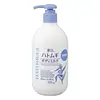What's inside
What's inside
 Key Ingredients
Key Ingredients

 Benefits
Benefits

 Concerns
Concerns

 Ingredients Side-by-side
Ingredients Side-by-side

Water
Skin ConditioningAlcohol Denat.
AntimicrobialEthyl Methoxycinnamate
UV AbsorberButylene Glycol
HumectantDipropylene Glycol
HumectantDimethicone
EmollientSteareth-6
EmulsifyingOctocrylene
UV AbsorberDiethylamino Hydroxybenzoyl Hexyl Benzoate
UV FilterCarbomer
Emulsion StabilisingAcrylates/C10-30 Alkyl Acrylate Crosspolymer
Emulsion StabilisingParaffinum Liquidum
EmollientCannabis Sativa Seed Extract
EmollientSqualane
EmollientSodium Hyaluronate
HumectantXanthan Gum
EmulsifyingDisodium EDTA
Sodium Hydroxide
BufferingTriethanolamine
BufferingBHT
AntioxidantPhenoxyethanol
PreservativeMethylparaben
PreservativeParfum
MaskingWater, Alcohol Denat., Ethyl Methoxycinnamate, Butylene Glycol, Dipropylene Glycol, Dimethicone, Steareth-6, Octocrylene, Diethylamino Hydroxybenzoyl Hexyl Benzoate, Carbomer, Acrylates/C10-30 Alkyl Acrylate Crosspolymer, Paraffinum Liquidum, Cannabis Sativa Seed Extract, Squalane, Sodium Hyaluronate, Xanthan Gum, Disodium EDTA, Sodium Hydroxide, Triethanolamine, BHT, Phenoxyethanol, Methylparaben, Parfum
Water
Skin ConditioningGlycerin
HumectantDipropylene Glycol
HumectantMethyl Gluceth-10
EmulsifyingPEG/PPG/Polybutylene Glycol-8/5/3 Glycerin
HumectantButylene Glycol
HumectantSodium Hyaluronate
HumectantCoix Lacryma-Jobi Ma-Yuen Seed Extract
Skin ConditioningDipotassium Glycyrrhizate
HumectantXanthan Gum
EmulsifyingStyrene/Acrylates Copolymer
PEG-60 Hydrogenated Castor Oil
EmulsifyingCitric Acid
BufferingSodium Citrate
BufferingPhenoxyethanol
PreservativeMethylparaben
PreservativePropylparaben
PreservativeWater, Glycerin, Dipropylene Glycol, Methyl Gluceth-10, PEG/PPG/Polybutylene Glycol-8/5/3 Glycerin, Butylene Glycol, Sodium Hyaluronate, Coix Lacryma-Jobi Ma-Yuen Seed Extract, Dipotassium Glycyrrhizate, Xanthan Gum, Styrene/Acrylates Copolymer, PEG-60 Hydrogenated Castor Oil, Citric Acid, Sodium Citrate, Phenoxyethanol, Methylparaben, Propylparaben
Ingredients Explained
These ingredients are found in both products.
Ingredients higher up in an ingredient list are typically present in a larger amount.
Butylene Glycol (or BG) is used within cosmetic products for a few different reasons:
Overall, Butylene Glycol is a safe and well-rounded ingredient that works well with other ingredients.
Though this ingredient works well with most skin types, some people with sensitive skin may experience a reaction such as allergic rashes, closed comedones, or itchiness.
Learn more about Butylene GlycolDipropylene Glycol is a synthetically created humectant, stabilizer, and solvent.
This ingredient helps:
Dipropylene glycol is technically an alcohol, but it belongs to the glycol family (often considered part of the ‘good’ alcohols). This means it is hydrating and gentle on skin unlike drying solvent alcohols like denatured alcohol.
As a masking agent, Dipropylene Glycol can be used to cover the smell of other ingredients. However, it does not have a scent.
Studies show Dipropylene Glycol is considered safe to use in skincare.
Learn more about Dipropylene GlycolMethylparaben is a preservative and is a paraben. It is used to prevent the growth of fungus, mold, and other harmful bacteria. Parabens are chemicals used as preservatives in both cosmetics and food.
Methylparaben can be synthetically created. It can also be found naturally in some fruits, such as blueberries.
Oftentimes, Methylparaben is combined with other parabens to help increase the shelf life.
The safety of Methylparaben is currently being studied. While ongoing studies are looking into the safety of parabens, the results have been very mixed. Some studies have not found Methylparaben to be harmful.
Learn more about MethylparabenPhenoxyethanol is a preservative that has germicide, antimicrobial, and aromatic properties. Studies show that phenoxyethanol can prevent microbial growth. By itself, it has a scent that is similar to that of a rose.
It's often used in formulations along with Caprylyl Glycol to preserve the shelf life of products.
Sodium Hyaluronate is hyaluronic acid's salt form. It is commonly derived from the sodium salt of hyaluronic acid.
Like hyaluronic acid, it is great at holding water and acts as a humectant. This makes it a great skin hydrating ingredient.
Sodium Hyaluronate is naturally occurring in our bodies and is mostly found in eye fluid and joints.
These are some other common types of Hyaluronic Acid:
Learn more about Sodium HyaluronateWater. It's the most common cosmetic ingredient of all. You'll usually see it at the top of ingredient lists, meaning that it makes up the largest part of the product.
So why is it so popular? Water most often acts as a solvent - this means that it helps dissolve other ingredients into the formulation.
You'll also recognize water as that liquid we all need to stay alive. If you see this, drink a glass of water. Stay hydrated!
Learn more about WaterXanthan gum is used as a stabilizer and thickener within cosmetic products. It helps give products a sticky, thick feeling - preventing them from being too runny.
On the technical side of things, xanthan gum is a polysaccharide - a combination consisting of multiple sugar molecules bonded together.
Xanthan gum is a pretty common and great ingredient. It is a natural, non-toxic, non-irritating ingredient that is also commonly used in food products.
Learn more about Xanthan Gum